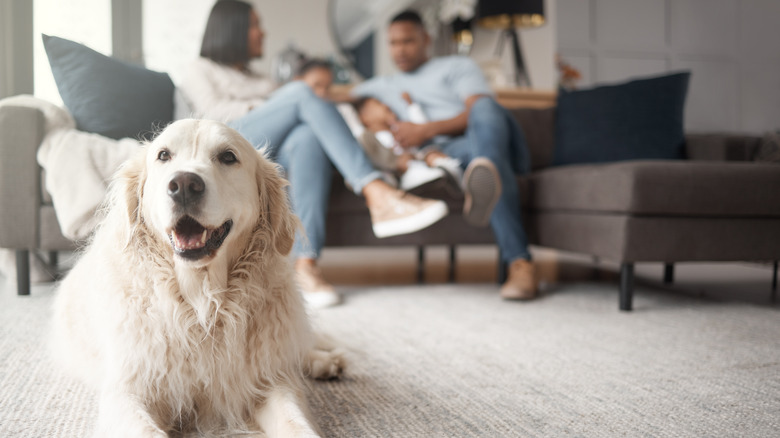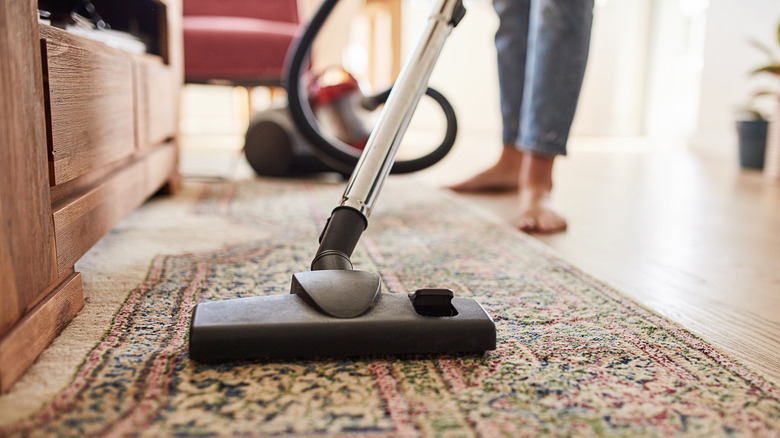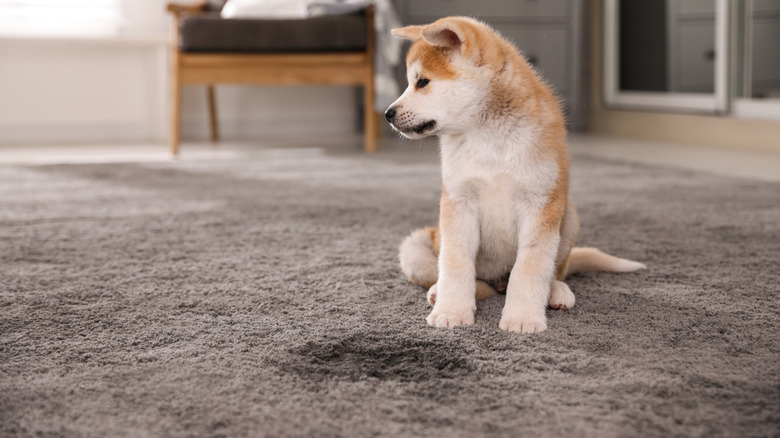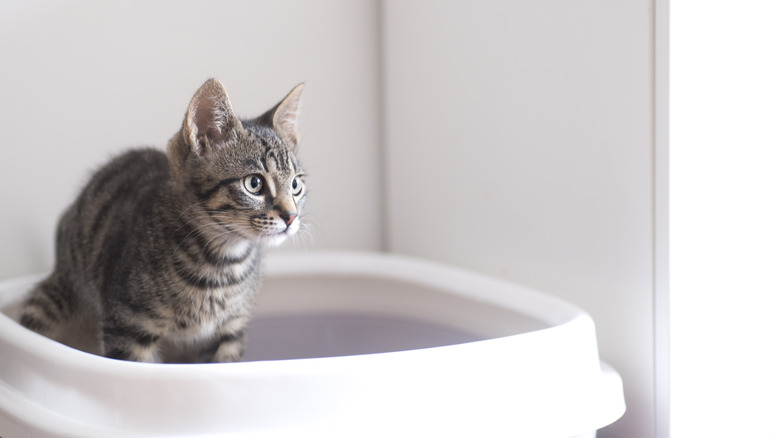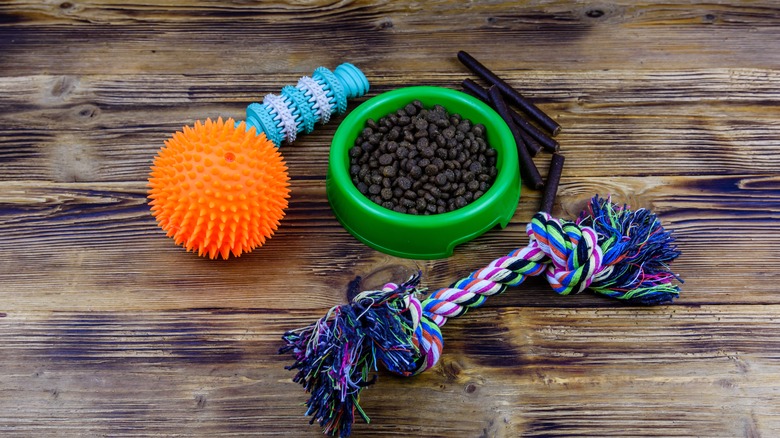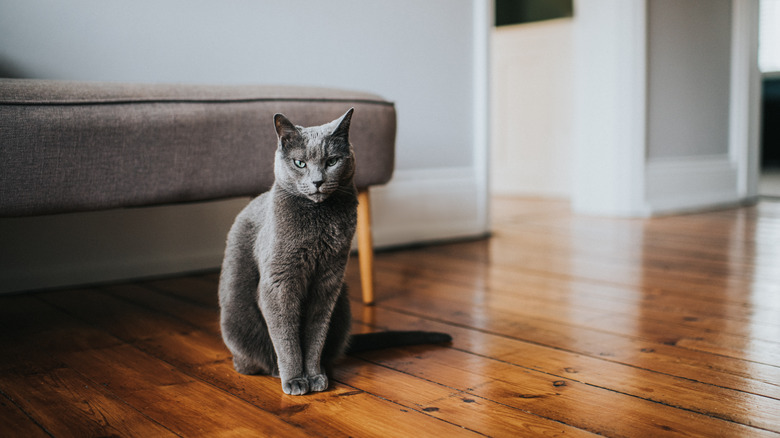Baking Soda Home Hacks That Pet Owners Swear By (& 2 To Avoid Trying)
Baking soda is a pantry staple with uses that go beyond cooking and removing odors from your fridge. In fact, if you have pets as part of your family, getting rid of odors and cleaning up accidents are some of the best ways to use baking soda in your home. This is all thanks to sodium bicarbonate, the key ingredient in baking soda, that has abrasive, liquid-absorbing, and odor-removing qualities.
You may want to use this pantry staple in lieu of other cleaning sprays if you're interested in a chemical-free, accessible, and affordable product. However, when considering the possible ways you can use it around pets, it's also important to know the ways baking soda is not effective. That way you're not thinking you're cleaning up messes when you're actually doing nothing. Furthermore, while non-toxic in small amounts, baking soda can actually be dangerous to pets if they accidentally ingest large quantities, so it's important to keep your furry loved ones out of the room when you're using it and cleaning. With that in mind, here are all the ways you can use baking soda in the home — and a few hacks to avoid.
Sprinkle baking soda to freshen up carpeting and upholstery
While carpeting can offer perks, such as comfort, safety, and noise reduction, this flooring is admittedly not the greatest when it comes to odors. If you have carpets in your home, then baking soda is a must-have item to keep on hand to help maintain the fabric's freshness — especially if you have cats and dogs. It can also be used on upholstery, such as fabric-based couches, pet beds, sofas, and chairs. The reason baking soda is so effective at odor removal is because of its key ingredient, sodium bicarbonate. It's an alkaline substance, which means it has the capability to neutralize acidic smells, such as pet urine and body odor. This is more practical than masking them with a can of scented air freshener — after all, once the perfume fades, the smell is still there.
To use this hack, sprinkle baking soda all over the surface you're looking to freshen. You can use more product in high-traffic areas or on specific parts of the floor or sofa your pets tend to favor. Let the product sit, and keep pets out of the area. When considering how long you should leave baking soda on your carpet to deodorize, this hack only requires 15 minutes (though you are free to leave it on overnight for heavier odors). After this time, you can remove the baking soda by vacuuming it up. However, before using this method, test out a small spot on a non-conspicuous area to make sure the baking soda doesn't ruin the color.
Use baking soda to absorb and treat accidents on rugs and carpets
Aside from its cleaning and deodorizing capabilities, baking soda can be an important tool for occasional accidents on carpets and rugs. The product works by absorbing liquids, including pet urine. Like other pantry items, such as cornstarch, the idea here is to help absorb the puddle before it becomes a stain and potentially ruins your carpeting or favorite rug. In addition, it has the added bonus of neutralizing the acidic smell of the urine, removing any potential odors from the material. Ideally, you'll want to use baking soda when the accident is fresh, though it is still possible to use it as a DIY carpet stain remover after the liquid dries.
To use baking soda for pet accidents, simply sprinkle a generous amount directly on top of the wet area. Once the product fully absorbs the urine, vacuum up any excess powder. In cases where the liquid has already dried, you will first want to apply baking soda over the fresh stain. Then, wet the affected area with a towel, preferably using hot water. Leave it on for at least three hours, or overnight, for best results. Vacuum the baking soda, and repeat the process if you see any remaining pet urine stains.
Use baking soda to deodorize your car if your dog rides with you
Whether you take your dog regularly in the car with you, or on an occasional basis for dog park visits and veterinary appointments, you will need to deodorize your vehicle to help remove and prevent smells. It turns out that baking soda works just as well in cars as it does inside your home for eliminating odors and keeping surfaces smelling fresh. This alkaline product can neutralize odors in your car in the same way as carpets and upholstery in your home. Whether the smell is coming from your pet's body odor or the bacteria left behind from their drool, the base powder will react with the acidic smells and change them into non-volatile sodium salts. Since they're not volatile, they won't have a smell.
To use baking soda in your car, sprinkle the product generously throughout your vehicle's surfaces. While you're most likely to focus on fabric seats and areas where your dog sits in your car, you can also use baking soda on floor mats to help provide more deodorizing action. Similar to carpeting and upholstery, you will want to leave the baking soda on surfaces for several minutes before thoroughly vacuuming up. Also, while this method is among one of the easiest ways to clean car seats, you should avoid using baking soda directly on leather upholstery.
Keep litter boxes fresh by adding a little bit of baking soda
Baking soda is known for deodorizing a number of areas in your home, and there are even commercial cleaners and other products that contain a small amount of baking soda for this purpose. And, it turns out, this all can be applied to your cat's litter box. Remember that baking soda can neutralize acidic odors, and this can include urine and feces smells in cat litter boxes. While you can buy commercial cat litter with baking soda already mixed in, you can do this hack on your own with your cat's current litter preference — and probably save some money, too. By adding baking soda directly to your cat's litter, you will not only reduce cat litter box odor, but you may also extend the freshness of the litter. This may also be a better option than using scented options, which can include fragrances your cat may not like, and subsequently avoid using their litter box.
To do this hack, add baking soda on the bottom of your cat's litter box up to ¼ inch-thick, and then place their normal litter on top. You can also sprinkle a small amount baking soda on top of the litter and mix in after each scooping session to help extend freshness before the next time you change out the entire box. As we mentioned earlier, baking soda can be toxic to animals if ingested in large quantities. That being said, it's generally considered safe to use in litter boxes, since your cat isn't likely to ingest the litter.
Don't use baking soda to disinfect or sanitize pet items
While baking soda can be used to remove and prevent odors, as well as for scrubbing certain surfaces, there is one major hidden downside of cleaning with baking soda: You cannot rely on this substance as a disinfectant or a sanitizer. When considering pet items, you'll want to avoid baking soda to remove germs from their food and water bowls, blankets, and toys.
If you're looking to kill germs from such items, there are a few alternatives to consider based on whether you're dealing with hard or soft surfaces. For example, you can use either diluted bleach (1/4 cup bleach per 1 gallon of water) or soapy water to wash hard toys and food or water bowls — just be sure to thoroughly rinse afterwards. You can even put these items in the dishwasher, so long as they are deemed dishwasher-safe by the manufacturer. On the other hand, soft toys, bedding, and blankets may be safely cleaned in the washing machine. If you are dealing with a toy that has feathers, or a combination of soft and hard components, however, you may need to spot clean these with disinfectant wipes, or with a towel or sponge with warm soapy water.
Don't use baking soda to clean up pet accidents on wood floors
While baking soda can help absorb accidents on carpeting, you should avoid using baking soda cleaning hacks on wood floors. This seemingly harmless quick fix to clean up a pet accident can ruin your floors. First, remember that baking soda is gently abrasive in nature, which are qualities that can scratch wood flooring. Furthermore, baking soda could potentially stain wood due to a high pH level. Baking soda essentially clashes with naturally-occurring tannins in the wood, creating a chemical reaction that could potentially darken the surface. Some of the most vulnerable woods include cherry, oak, mahogany, and walnut.
Instead, if you're looking for a natural wood cleaner for pet accidents, try a DIY version made with 2 tablespoons vegetable or olive oil, 2 tablespoons vinegar, and ¼ cup of lemon juice mixed in a spray bottle. Spray the solution on your floor and mop as you would with any other floor cleaner. If you do happen to accidentally spill baking soda on your wood floors during some of the other uses on this list, vacuum it up immediately to help prevent further damage. Stained wood from baking soda may also need professional sanding.
